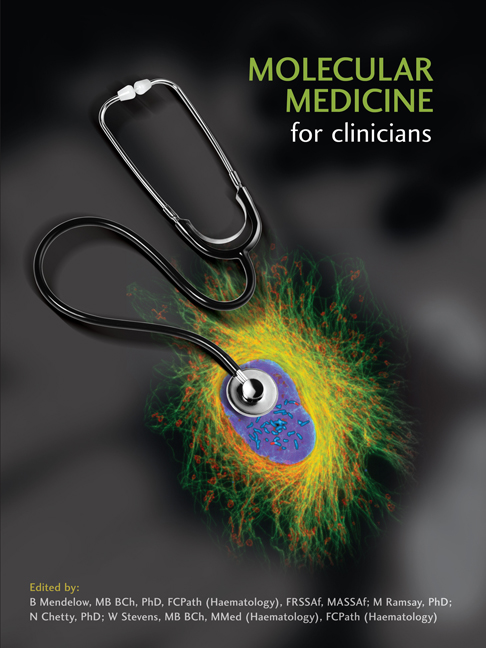Book contents
- Frontmatter
- Contents
- Foreword
- Acknowledgements
- Chapter 1 Introduction
- Keynote Essay 1: Defining Who We Are: DNA in Forensics, Genealogy and Human Origins
- Section 1 Principles Of Cellular And Molecular Biology
- SECTION 2 MOLECULAR PATHOLOGY
- SECTION 3 MOLECULAR THERAPEUTICS
- Chapter 32 Targets for Molecular Therapy: The Biology of Haemostasis
- Chapter 33 Cellular Targets of Antiplatelet Agents
- Chapter 34 Rational Drug Design
- Chapter 35 Chronic Myeloid Leukaemia
- Chapter 36 Gene Therapy
- Chapter 37 Diabetes Mellitus
- Chapter 38 Pharmacogenetics
- Chapter 39 Basic Molecular Biology of Blood Groups
- Keynote Essay 6: Molecular Research Case Study: Developing Novel RNA Interference-based Therapy
- SECTION 4 RESEARCH AND THE CONTINUING EVOLUTION OF MOLECULAR MEDICINE
- Glossary
- Contributors’ Biographies
- Source Material And Recommended Reading
- Permissions And Credits
- Index
Chapter 32 - Targets for Molecular Therapy: The Biology of Haemostasis
from SECTION 3 - MOLECULAR THERAPEUTICS
Published online by Cambridge University Press: 04 June 2019
- Frontmatter
- Contents
- Foreword
- Acknowledgements
- Chapter 1 Introduction
- Keynote Essay 1: Defining Who We Are: DNA in Forensics, Genealogy and Human Origins
- Section 1 Principles Of Cellular And Molecular Biology
- SECTION 2 MOLECULAR PATHOLOGY
- SECTION 3 MOLECULAR THERAPEUTICS
- Chapter 32 Targets for Molecular Therapy: The Biology of Haemostasis
- Chapter 33 Cellular Targets of Antiplatelet Agents
- Chapter 34 Rational Drug Design
- Chapter 35 Chronic Myeloid Leukaemia
- Chapter 36 Gene Therapy
- Chapter 37 Diabetes Mellitus
- Chapter 38 Pharmacogenetics
- Chapter 39 Basic Molecular Biology of Blood Groups
- Keynote Essay 6: Molecular Research Case Study: Developing Novel RNA Interference-based Therapy
- SECTION 4 RESEARCH AND THE CONTINUING EVOLUTION OF MOLECULAR MEDICINE
- Glossary
- Contributors’ Biographies
- Source Material And Recommended Reading
- Permissions And Credits
- Index
Summary
INTRODUCTION
Some of the early candidate molecules identified as having potential therapeutic value included proteins involved in the promotion or inhibition of the normal clotting mechanisms, for use in inherited or acquired bleeding or clotting disorders, respectively. In order to understand the rational use of such molecules, which could be produced as recombinant proteins or incorporated into gene therapy strategies, it is necessary to have a thorough understanding of the molecular and cellular mechanisms of the normal physiological haemostatic (‘stopping of bleeding’) process. The primary principle of haemostasis is to minimise blood loss at sites of vessel injury by forming a thrombus (clot) and at the same time maintaining blood flow (Figure 1). In order to achieve this there is a highly regulated, fine-tuned interaction of multiple processes, involving the blood vessel wall, principally the endothelium, plate lets and noncellular blood constituents.
The core elements of haemostasis include vasoconstriction, platelet activation, the pro cess of coagulation and fibrinolysis (clot break - down). All of these processes are initiated simultaneously, triggered by a breach in blood vessel integrity. Endothelial cell damage results in exposure of collagen, which triggers platelet adhesion and activation, while tissue factor expression activates the coagulation cascade resulting in the formation of a fibrin meshwork.
Platelet adhesion and activation is conventionally known as ‘primary haemostasis’ and the process of coagulation and fibrin formation as ‘secondary haemostasis’. In simplistic terms, the platelet plug can be considered to be the ‘bricks’ and the fibrin meshwork the ‘cement’, both being required for the formation of a stable thrombus.
PLATELET ADHESION AND ACTIVATION
Platelets play a critical role in the normal physiology of haemostasis. At sites of endothelial cell injury, platelets adhere to a variety of subendothelial matrix structures via a multitude of platelet surface receptors.
- Type
- Chapter
- Information
- Molecular Medicine for Clinicians , pp. 383 - 390Publisher: Wits University PressPrint publication year: 2008



